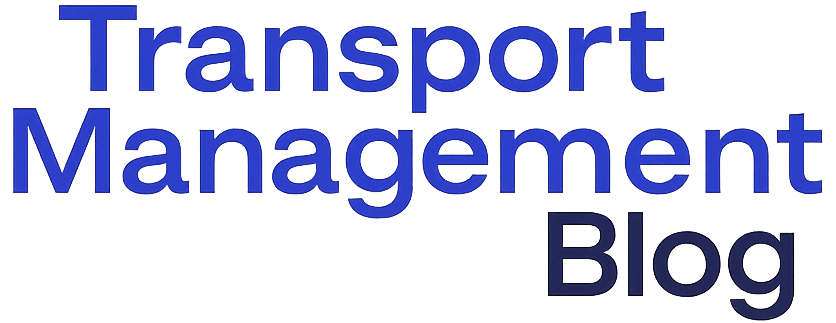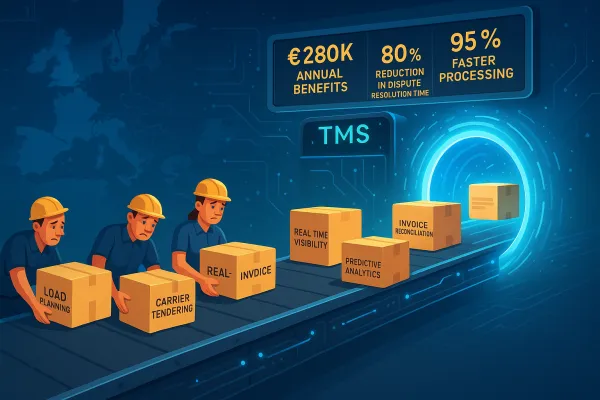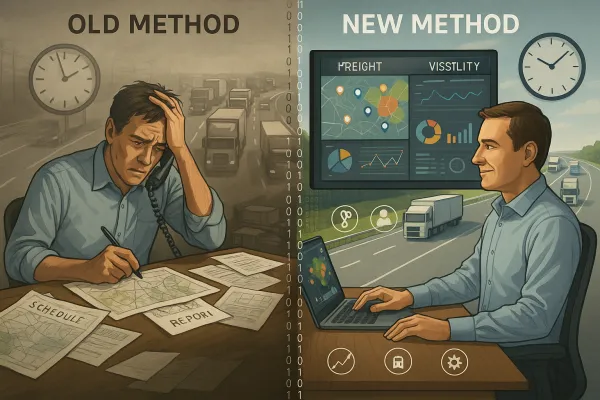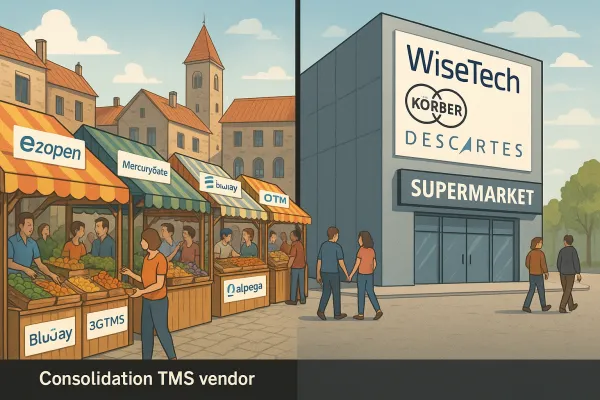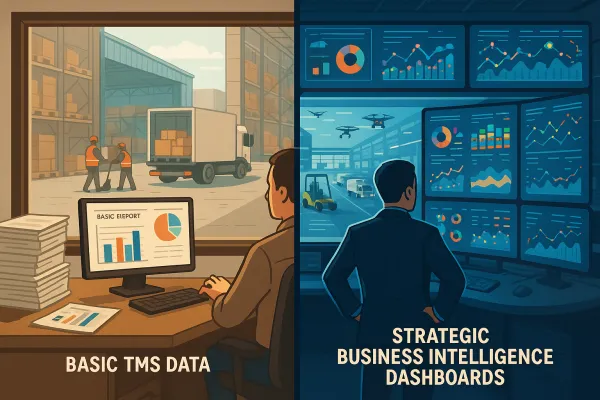From Crisis to Competitive Advantage: How European Shippers Can Use AI and Automation to Combat the 426,000 Driver Shortage
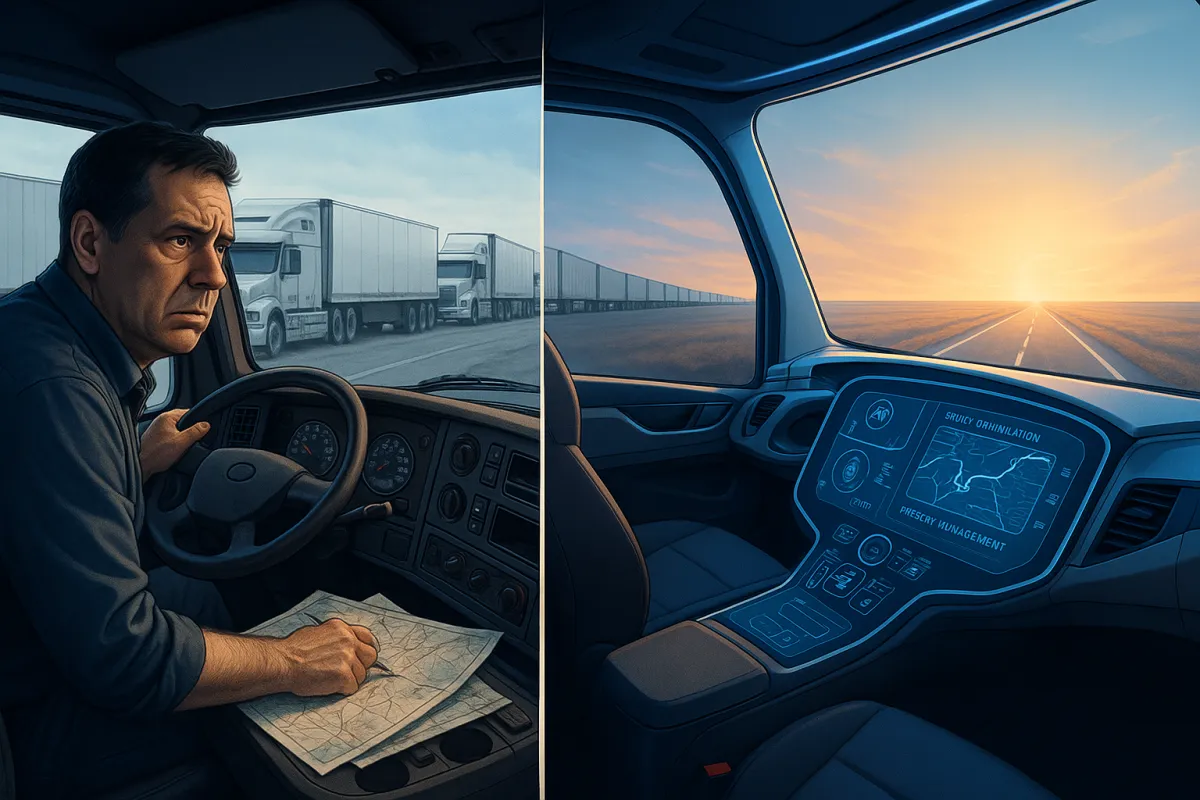
Coming into 2025, industry surveys showed over 426,000 unfilled truck driver positions across Europe, and without intervention this gap is projected to worsen dramatically – potentially exceeding 60% of driver positions unfilled by 2026 under current trends. For European shippers managing their own fleets, this isn't just a staffing problem—more than half of European trucking companies report they cannot expand due to driver shortages; 48% are experiencing lower productivity, and 39% are seeing revenue decline.
The numbers behind Europe's transport crisis paint a clear picture. The average European truck driver is 47 years old, and 30% are over 55 — a retirement cliff is looming. At the same time, only 5% of drivers are under 25, and a mere 4% are women. While wages have increased significantly—in Italy a new sector agreement raised driver pay by €500+ per month in 2025 to compensate time lost waiting at loading sites. Across Europe, more than half of operators have increased salaries or offered performance bonuses to improve retention—traditional recruitment strategies aren't solving the structural workforce imbalance.
This is where AI and automation technologies offer European shippers a path from crisis to competitive advantage. According to McKinsey, over a third of businesses deploying AI-based software for the supply chain reduced more than 20% of their costs. The question isn't whether to invest in these technologies, but how to implement them strategically to offset both driver shortages and escalating transport costs.
The Scale of Europe's Driver Shortage Crisis in 2025
The European road transport sector faces an unprecedented workforce challenge. The growing chasm between retiring and new drivers is set to triple the rate of unfilled truck driver positions, to over 60% by 2026, and increase by more than five-fold for bus and coach drivers, to almost 50% by 2026.
The economic barriers to entry remain substantial. In France, a truck licence costs EUR 5,300, more than three times the average minimum monthly salary, while in Germany, a bus and coach license costs EUR 9,000 on average, over four times the minimum monthly wage. These costs create a significant obstacle for young people entering the profession, contributing to the demographic imbalance.
The business impact extends far beyond simple capacity constraints. Countries like Estonia and Poland are already seeing the impact, with local operators forced to decline shipments or raise prices due to staffing shortages. The cost implications ripple through the entire supply chain—tighter capacity, wage inflation, higher insurance costs, and volatile fuel prices all compound to create a perfect storm of rising transport costs.
Why Traditional Recruitment Isn't Enough
The demographic challenges run deeper than most European shippers realize. The average European truck driver is around 47 years old, and one-third of drivers are over 55 (many nearing retirement) while less than 5% are under 25. In major haulage markets the age imbalance is even more acute – across 35 countries surveyed, young drivers under 25 account for only ~6.5% of the workforce, with figures as low as 2–3% in countries like Germany, Poland and Italy.
Gender diversity remains limited. Only about 4% of European truck drivers are female, reflecting an untapped pool of potential talent if industry conditions improve. Security concerns play a significant role—95% of truck drivers and 94% of transport companies putting security as their top priority for women drivers. Yet only 3% of existing EU truck parking places are certified as secure.
Even with increased wages and improved working conditions, the "Great Retirement" effect will continue to accelerate. Despite these efforts, the driver shortage will remain a structural challenge in 2025 and beyond. This reality forces European shippers to look beyond traditional solutions.
The AI and Automation Solution Landscape
The transport management technology landscape is rapidly evolving to address these challenges. Transportation management systems are beginning to integrate artificial intelligence to unlock new levels of automation, improve decision-making and enable greater configurability.
Early implementations show concrete value delivery. According to a recent Gartner study, companies that have adopted an API-connected TMS have seen their productivity increase by 27% and their operational costs decrease by 23% on average. Major TMS vendors like MercuryGate, Descartes, and Transporeon are integrating AI capabilities, while emerging solutions like Cargoson offer more agile alternatives for European shippers looking to implement these technologies quickly.
The technology is becoming increasingly accessible. Cloud-based solutions are making it more affordable for these smaller companies to invest in a TMS. The majority of TMS solutions are connected to the cloud, which means they may be accessed from any remote device with a secure internet connection. This democratization of advanced transport management tools means even mid-sized European manufacturers can now access enterprise-level capabilities.
AI is taking over the guesswork, turning raw data into real-time, predictive insights. AI-driven predictive analytics now power compliance automation, contract and quote management, cost optimization, fleet and incident management, and sustainability tracking. The integration of AI is no longer an enhancement—it's the driving force behind the TMS in supply chain transformation.
Immediate AI Solutions for Driver Efficiency
Smart European shippers are deploying AI solutions that amplify their existing driver workforce rather than simply trying to replace it. Predictive maintenance stands out as one of the most impactful applications. A breakdown on the road costs more than just repair, it can delay deliveries, disappoint customers, and damage brand trust. AI helps prevent that by enabling predictive maintenance. Sensors collect data on engine health, tire pressure, fuel efficiency, etc.
The operational benefits extend beyond maintenance. Predictive data analysis: anticipation of delays, proactive optimization of routes, automation of complex tasks that previously required human intervention, optimization suggestions based on analysis of your historical data lead to 35% reduction in time spent on administrative tasks, 25% improvement in the accuracy of delivery forecasts, and 20% decrease in kilometers traveled thanks to better optimization.
Modern AI-powered TMS solutions from providers like Oracle TM, SAP TM, and 3GTms now include driver coaching systems with performance insights. Companies like FreightPOP, nShift, and Shipstation offer digital freight platforms that reduce empty miles, while newer entrants like Cargoson focus specifically on the European market's regulatory requirements and operational patterns.
Driver safety and performance coaching systems use AI to analyze driving patterns and provide real-time feedback. If a driver's aggressive style burns 8% more fuel, the system flags coaching opportunities. Micro-savings add up to tens of thousands of euro annually, creating genuine economical fleet management.
Route Optimization and Load Consolidation
One of the most immediate applications for European shippers involves addressing the current inefficiency in freight movements. Adopt freight exchanges and digital platforms: Less downtime, fewer empty miles, better job satisfaction. The current waste in the system is substantial—industry data shows that approximately 23% of journeys involve empty miles.
AI-powered load consolidation delivers measurable results. If two trucks leave half-empty to neighbouring regions, the TMS proposes load consolidation. Once the baseline is clear, the AI layer suggests corrective actions: grouping partial loads, switching delivery windows or adjusting driver assignment.
Cross-docking and collaborative freight consolidation become more feasible with AI systems that can analyze demand patterns across multiple shippers. The technology enables better coordination with carriers, reducing the need to maintain large driver pools while improving asset utilization across the network.
Strategic Cost Management While Investing in Technology
European shippers face a delicate balancing act: investing in technology while managing immediate cost pressures. In 2025, logistics is in turmoil: costs are soaring (+5.5% in 2024, +3.3 to 7.3% expected this year), fuel accounts for 25 to 30% of the budget, and the driver shortage is pushing wages up.
Building contract flexibility becomes crucial. Index-linked surcharges and dynamic pricing mechanisms help protect against volatile costs while maintaining carrier relationships. Many European shippers are securing dedicated carriers and investing in driver-friendly facilities to ensure capacity access.
The ROI from TMS automation justifies the investment. Over a third of businesses deploying AI-based software for the supply chain reduced more than 20% of their costs. We can condense all benefits of transport management systems into one: it makes you more profitable.
TMS benefits extend beyond immediate cost savings. Automated processes. Robotic process automation, reporting, and automatic notifications can improve operational processes and free your employee's time for value-added tasks. Additionally, automated transportation management systems can prevent billing errors, streamline reporting, and help you plan your budget.
Major TMS solutions from Manhattan Active, Blue Yonder, and E2open now offer comprehensive automation capabilities, while agile alternatives like Cargoson provide cost-effective options specifically designed for European regulatory requirements and mid-market implementation timelines.
Implementation Roadmap for European Shippers
Most European transport managers don't initially see AI as a priority, yet the technology directly addresses their top concerns: rising costs and regulatory compliance. Organizations are advised to pilot AI applications in limited use cases—such as automated bid comparison or route forecasting—before scaling them across all operations. AI tools often change decision-making processes or shift roles. Clear documentation, training, and stakeholder communication and buy-in are important for successful adoption.
The first step involves assessment of current operations. AI models need clean, timely, and structured data. Inconsistent data from ERP, WMS, and TMS systems must be resolved before automation will work reliably, and be trustworthy. This data foundation work pays dividends as it improves visibility regardless of AI implementation.
Pilot programs should focus on high-impact, low-risk applications. Route optimization and predictive maintenance deliver quick wins while building organizational confidence in AI capabilities. Eric Rempel, chief innovation officer for Redwood Logistics, expects to see the transportation industry adopt AI at a gradual pace initially, then ramp up quickly. It will start with optimizing straightforward areas of workflow management.
Industry adoption is accelerating across Europe. 76% of logistics transformations fail to achieve their performance objectives. The difference between success and failure? A methodical approach to measuring return on investment, based on concrete and verifiable metrics. Companies implementing dashboards for end-to-end visibility report significant improvements in operational efficiency.
Established vendors like Descartes, Alpega, and Oracle TM offer comprehensive platforms with proven track records, while newer solutions like Cargoson provide the flexibility and speed that European mid-market shippers need for rapid deployment.
Building the Business Case
The economic justification for AI and automation investment becomes compelling when viewed against the alternative of maintaining status quo operations. Building a solid cost strategy 2025 involves five steps: 1) digitise every cost line (no Excel silos), 2) integrate ERP + TMS, 3) activate predictive AI, 4) define measurable cost-to-serve KPIs, 5) review performance quarterly. SMEs that complete the cycle routinely cut cost-per-kilometre from €0.22 to €0.18, making them competitive against larger carriers.
The efficiency gains from 24/7 automated operations help offset driver shortages while reducing total operational costs. Through automation implementation and the elimination of legacy system maintenance costs, the client achieved a 17% reduction in operational expenses. At the same time, the company enhanced warehousing efficiency by 29%.
Preventive maintenance alone delivers substantial savings. Early failure detection prevents costly breakdowns and reduces vehicle downtime. Combined with optimized routing and load consolidation, these technologies create cumulative benefits that justify the initial investment within 12-18 months for most European shippers.
Looking Ahead: Long-term Automation Strategy
While fully autonomous trucks remain years away from widespread European deployment, the development of highway automation continues to progress. Current pilots focus on hub-to-hub routes in controlled environments, with EU Horizon Magazine reporting on expanding commercial trials across European corridors.
McKinsey and World Economic Forum forecasts suggest that 30% of new US truck sales could be autonomous by 2035 for specific hub-to-hub routes. European adoption may follow a similar timeline, though regulatory frameworks and infrastructure requirements will influence the pace of deployment.
The immediate reality remains clear: European shippers must make trucking more attractive and efficient while these longer-term technologies mature. AI and automation provide the bridge between current challenges and future solutions. Sustainability is no longer optional, it's a competitive differentiator. AI plays a key role in helping companies shrink their carbon footprint while growing operational efficiency.
The companies that will thrive are those positioning themselves as technology-forward employers while building the operational capabilities needed for an automated future. Companies embracing AI today lock in permanent savings, happier customers and scalable operations. The future belongs to transport firms that transform data into euros saved and kilometres made cleaner.
For European logistics companies, the window for competitive advantage through early AI adoption is narrowing. Whether working with established platforms like Oracle TM or agile solutions like Cargoson, the key is starting with focused pilot projects that deliver measurable value while building the organizational capability for broader digital transformation.
The 426,000 driver shortage isn't going away, but European shippers who act decisively can turn this crisis into their competitive advantage. The technology exists, the business case is proven, and the time for implementation is now.
